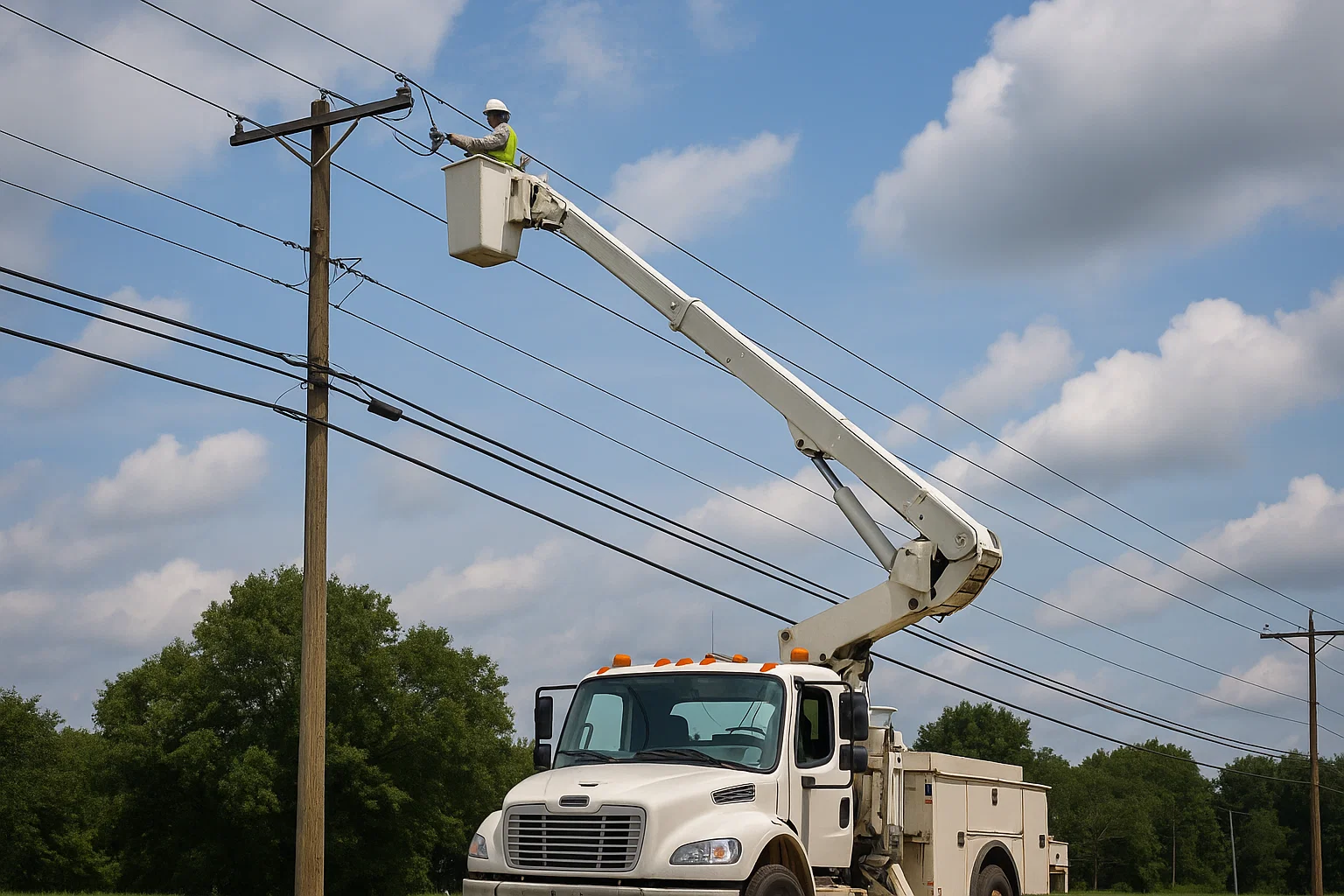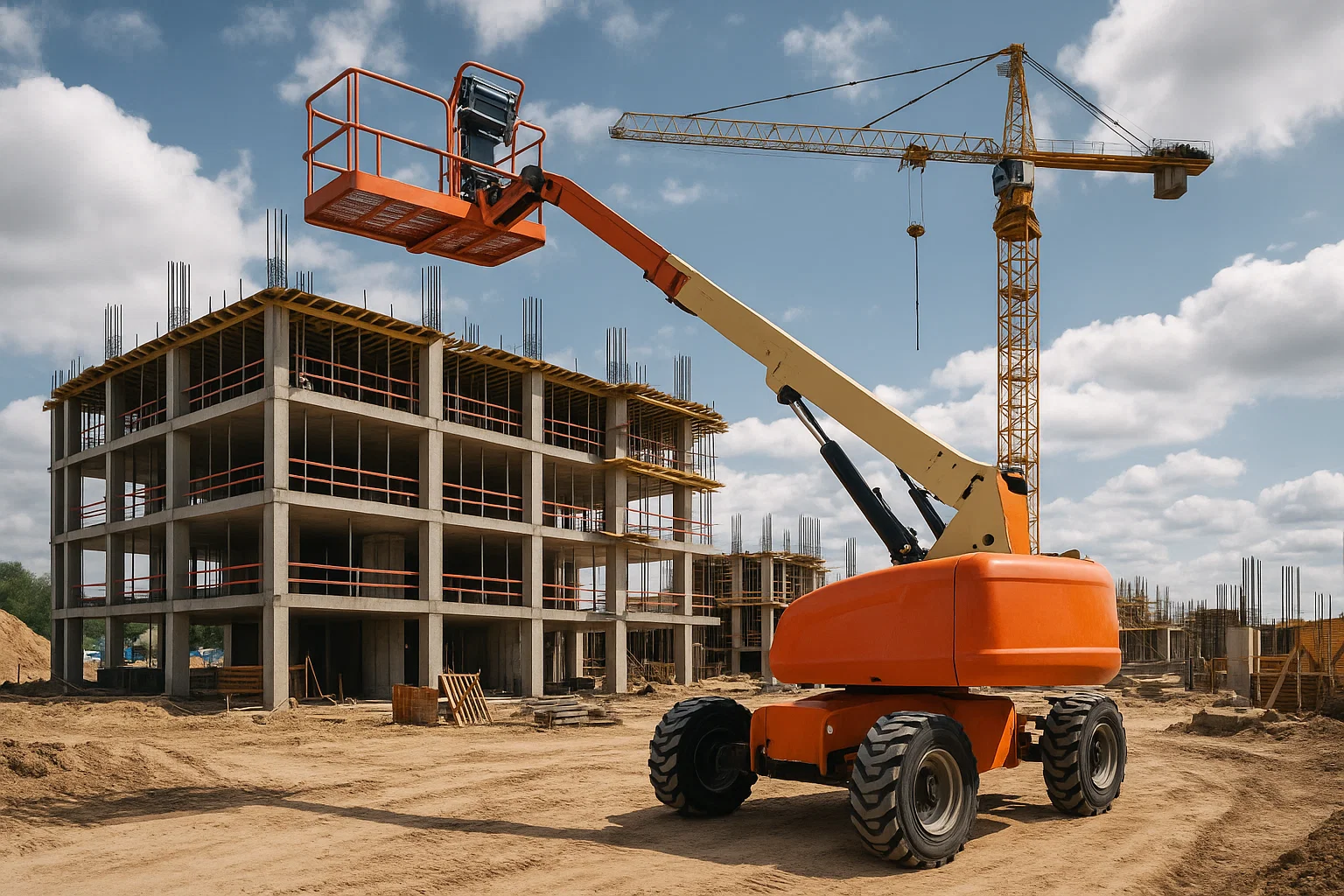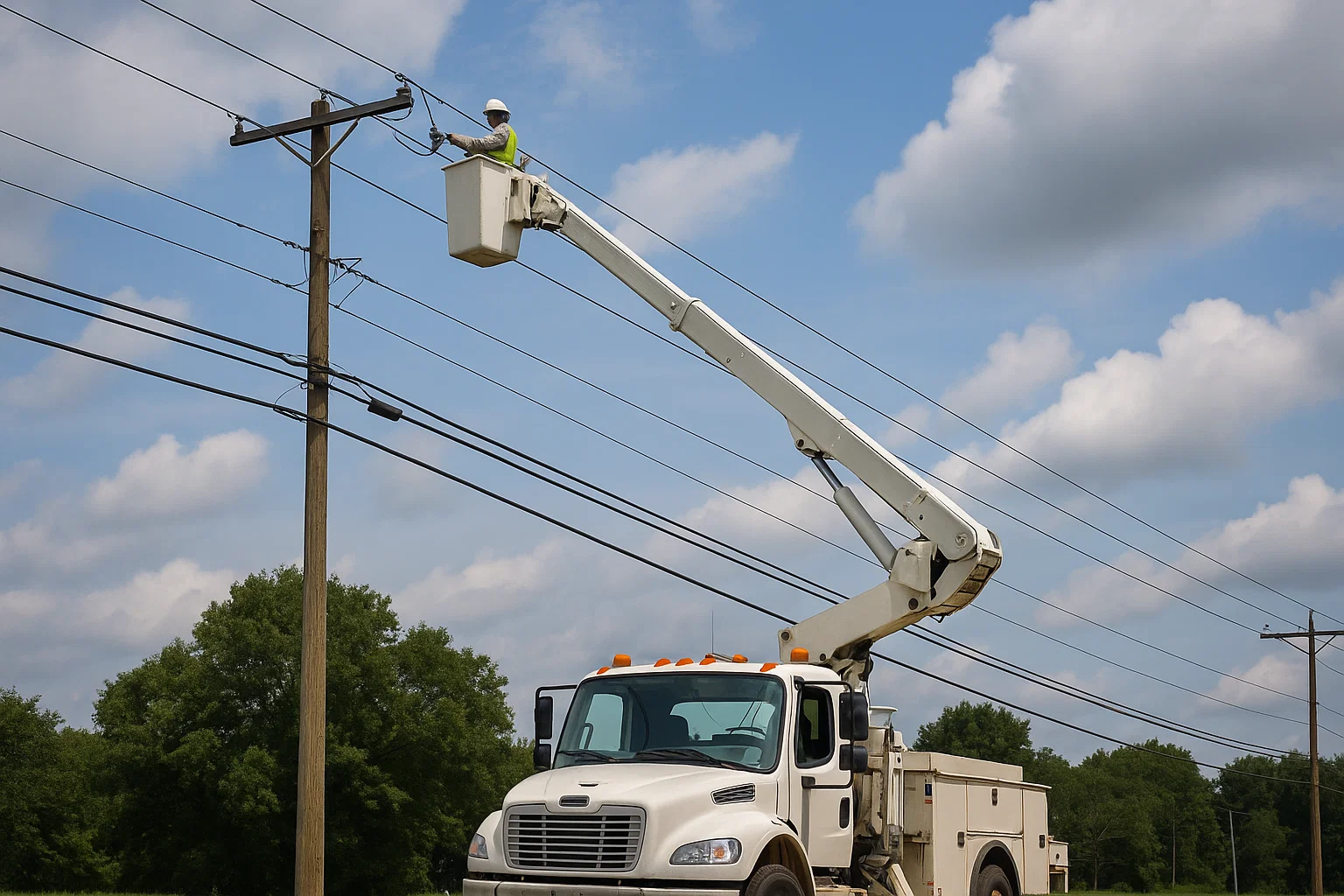
8 min read
Your project manager just called with an urgent request: the electrical contractor needs elevated access for overhead work starting Monday, but you're not sure whether to rent a boom lift or bucket truck. The wrong choice could mean wasted time repositioning equipment, accessibility problems that delay the project, or safety issues that shut down operations entirely. With rental costs adding up and deadlines looming, this decision matters more than you might think.
Quick Answer: Boom lifts offer greater reach, terrain flexibility, and height capacity, making them ideal for construction and industrial work on uneven surfaces. Bucket trucks provide superior mobility and self-contained transport, perfect for roadside work, utility maintenance, and jobs requiring frequent repositioning. Your choice depends on terrain conditions, reach requirements, mobility needs, and project duration. Both require OSHA-compliant operator certification and ANSI A92 compliance.
When your team needs elevated access for work at height, selecting the right aerial lift becomes important for jobsite efficiency, worker safety, and budget management. Two of the most common options—boom lifts and bucket trucks—often serve similar elevated access functions but differ significantly in design characteristics, mobility capabilities, and optimal use cases.
For jobsite managers and supervisors, understanding these key differences helps guide smarter equipment decisions that align with specific project requirements and operational constraints.

Boom lifts, also called cherry pickers or man lifts, represent standalone machines featuring hydraulic arms and work platforms that provide both vertical and horizontal reach capabilities. These versatile units come in two primary configurations: articulating booms that bend at multiple joints for obstacle navigation, and telescopic booms that extend straight out for maximum reach.
Construction projects, industrial maintenance operations, and large-scale facility work commonly rely on boom lifts because of their superior reach and positioning flexibility. These applications often require access to complex structures, elevated work around obstacles, or positioning at precise locations that demand both height and horizontal extension.
Extended reach capabilities represent the primary advantage of boom lifts, with both horizontal and vertical extension making them significantly more versatile than fixed-position alternatives. Articulating models can work up, over, and around obstacles that would block other equipment types, while telescopic models provide straight-line reach that exceeds most other aerial platforms.
Terrain flexibility through specialized rough-terrain models allows boom lifts to operate effectively on uneven surfaces, soft ground, and challenging outdoor conditions. Four-wheel drive capabilities, oscillating axles, and aggressive tread patterns enable access to areas where wheeled vehicles cannot operate safely.
Height capacity often exceeds bucket truck capabilities, with some boom lift models reaching 180 feet or more. This extreme height capability makes boom lifts suitable for work on tall structures, high-rise construction, and industrial facilities with significant vertical requirements.
Transportation requirements represent the primary limitation of boom lifts, as most models need trailers or flatbed trucks for site-to-site movement. This transportation dependency adds complexity and cost to projects requiring frequent relocation between work areas.
Setup time and positioning requirements make boom lifts less efficient for quick, short-duration tasks that require immediate access. The time needed to transport, position, and stabilize boom lifts may exceed the actual work time for brief maintenance or inspection tasks.
ANSI A92 standards for mobile elevating work platforms (MEWPs) govern boom lift design, operation, and safety requirements, making compliance verification important during equipment selection and operator training.

Bucket trucks, also known as aerial devices or utility trucks, integrate hydraulic boom systems directly into vehicle chassis, creating self-contained units that combine transportation and elevated access capabilities. The boom and work platform are permanently mounted to truck bodies, allowing operators to drive directly between job locations without additional transport equipment.
Utility companies, arborists, sign maintenance crews, and telecommunications technicians commonly use bucket trucks because their integrated design supports the frequent repositioning and roadway access requirements typical in these industries.
Superior mobility represents the defining advantage of bucket trucks, as they can be driven directly to work locations without requiring trailers, escorts, or special transport arrangements. This self-contained design enables rapid response to emergency calls and efficient scheduling of multiple jobs throughout a single work shift.
Integrated power systems typically draw energy from the vehicle's engine through power take-off (PTO) systems, eliminating the need for separate power sources or battery charging requirements. This integration ensures consistent power availability and reduces complexity compared to battery-powered alternatives.
Vertical work optimization makes bucket trucks particularly effective for tasks like power line maintenance, tree trimming, street light service, and sign installation. The boom design and work platform configuration excel at positioning operators directly above or alongside work targets.
Professionals at HercRentals emphasize important safety considerations for electrical work, recommending a key guideline: "If bucket trucks are not labeled as insulated, then consider them non-insulated bucket trucks." This distinction becomes important when working around electrical hazards.
Limited horizontal reach compared to boom lifts restricts bucket trucks to work areas directly above or closely adjacent to the vehicle position. This limitation reduces effectiveness for tasks requiring significant horizontal extension or work around obstacles.
Road accessibility restrictions confine bucket trucks to areas accessible by wheeled vehicles, eliminating their use on rough terrain, soft ground, or areas without adequate access routes. Construction sites and remote locations often present access challenges that prevent bucket truck deployment.
Height limitations typically restrict bucket trucks to lower elevations compared to specialized boom lifts, though this varies significantly by model and application requirements.
OSHA provides specific guidance for bucket truck safety considerations, particularly regarding electrical hazards and proper operating procedures for utility and maintenance work.
Your optimal aerial lift selection depends on multiple factors including task nature and duration, ground conditions and terrain, repositioning frequency requirements, and overall project logistics. Systematic evaluation of these factors helps guide decisions that optimize both safety and productivity.
Off-road and uneven terrain applications strongly favor boom lifts because of their specialized mobility features and stability systems. Construction sites, industrial facilities, and remote locations often present ground conditions that prevent wheeled vehicle access.
Maximum reach and articulation requirements make boom lifts the preferred choice for complex structures like stadiums, industrial facilities, bridges, and multi-story buildings. When work requires positioning around obstacles or accessing hard-to-reach areas, boom lift flexibility provides significant advantages.
Extended duration projects benefit from boom lift capabilities when the equipment will remain in position for days or weeks. The transportation requirements become less significant when equipment stays in one location for extended periods.
Roadway and power line work represents the ideal application for bucket trucks because of their mobility and positioning capabilities. Utility maintenance, street lighting, traffic signal service, and similar applications require frequent repositioning along accessible routes.
Quick tasks requiring frequent repositioning favor bucket trucks because their integrated design eliminates transportation delays between work locations. Service calls, inspections, and brief maintenance tasks benefit from immediate accessibility and rapid deployment.
Self-contained lift-and-transport requirements make bucket trucks ideal when project logistics prevent the use of separate transport vehicles or when trailer towing restrictions apply. Urban environments and congested work areas often favor the compact, integrated approach.
Some complex projects benefit from deploying both equipment types to maximize operational flexibility and address diverse access requirements throughout the work scope.
Both boom lifts and bucket trucks require compliance with OSHA safety regulations and ANSI standards that govern aerial platform operation, maintenance, and operator training. Understanding these requirements helps ensure safe deployment regardless of equipment type selected.
Operator certification requirements apply to both equipment categories, with OSHA mandating proper training and competency demonstration before personnel can operate aerial lifts safely. Training must address equipment-specific characteristics and workplace hazards relevant to each application.
Fall protection requirements, pre-operational inspections, and emergency procedures apply equally to both boom lifts and bucket trucks, though specific implementation may vary based on equipment design and intended applications.
Regular maintenance and inspection schedules help ensure continued safe operation while meeting regulatory compliance obligations that apply to all aerial platform equipment.
Equipment selection should consider both direct rental or purchase costs and indirect expenses related to transportation, setup time, and operational efficiency. Total project costs often differ significantly from basic equipment rental rates.
Boom lift projects typically incur higher transportation costs but may provide better productivity for complex positioning requirements. The ability to access difficult locations may justify additional transportation expenses through reduced project duration.
Bucket truck applications often provide better cost efficiency for multiple-location projects because integrated mobility eliminates separate transportation expenses and reduces setup time between locations.
Rental options exist for both equipment types, making temporary access cost-effective for short-term projects while avoiding the capital investment and maintenance obligations of equipment ownership.
Both boom lifts and bucket trucks provide valuable elevated access capabilities, but understanding their different strengths helps guide optimal equipment selection for specific project requirements. The right choice depends on careful evaluation of terrain, mobility needs, reach requirements, and project logistics.
Consider terrain conditions, positioning requirements, project duration, and transportation logistics when making equipment decisions. These factors often have more impact on project success than basic equipment capabilities.
Always prioritize safety standards, proper operator certification, and regulatory compliance regardless of equipment type selected. Both boom lifts and bucket trucks require trained operators and systematic safety management for successful deployment.
Q: What training options are available for boom lifts and bucket trucks?
A: Prosafe offers comprehensive operator certification and train-the-trainer programs that address both equipment types. Our programs include classroom instruction, hands-on evaluation, and documentation that meets OSHA and ANSI requirements for aerial lift operations. We come to you and train your operators on your own equipment.
Q: Can I use a bucket truck for construction work?
A: Bucket trucks can handle some construction tasks, but they're less suitable for structural or indoor work. Boom lifts offer greater flexibility and reach for complex construction sites with varied access requirements and obstacle navigation needs.
Q: Are boom lifts more dangerous than bucket trucks?
A: Both equipment types present safety risks if not operated properly. Boom lifts often work at greater heights and in more challenging conditions, making operator training and safety procedures particularly important. Always follow OSHA guidelines for either equipment type.
Q: Which type of lift is easier to maintain?
A: Bucket trucks may have maintenance advantages because their integrated vehicle design consolidates service requirements. However, both types require regular inspections and maintenance per ANSI and OSHA regulations, making proper maintenance planning important regardless of equipment choice.
Q: Can I rent these lifts instead of purchasing them?
A: Yes, both boom lifts and bucket trucks are widely available for rental. Renting can be cost-effective for short-term or specialized projects while avoiding the capital investment and ongoing maintenance responsibilities of equipment ownership.
Q: Do operators need special certification for both types?
A: Yes, OSHA requires trained and certified operators for all aerial lift equipment. ANSI A92 standards also apply to mobile elevating work platforms. Certification must address specific equipment types and workplace hazards relevant to your applications.
Select the optimal aerial lift equipment for your specific project requirements with expert guidance that considers terrain, reach, mobility, and safety factors. Our equipment specialists help evaluate your access needs and recommend solutions that maximize productivity while maintaining safety compliance. Call (866) 350-9156 or request a consultation to determine the best aerial lift approach for your upcoming projects.